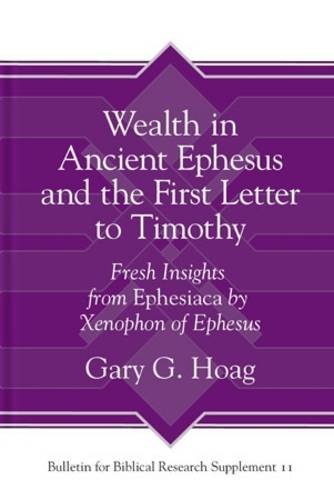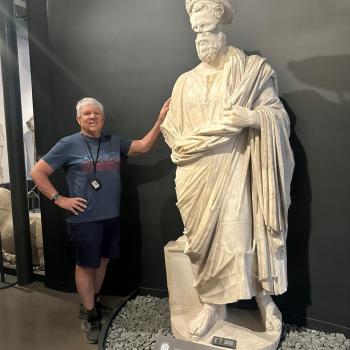Q6b.BEN: I also found it puzzling that you found the Eve example not to have anything to do with her instruction, and yet the Genesis story tells us that only Adam received the proper instruction about the tree, and apparently did a lousy job of conveying the one commandment to Eve. In other words, she was deceived because she had not first been properly instructed, which Paul sees as the danger with these elite women he is discussing. Finally, I was puzzled by your reading of 1 Tim. 2.15 where attention has to be paid to the definite article before ‘childbearing’ but ‘the woman will be will be saved through the childbearing (singular). Surely, this is a reference to Mary as being the counter example to Eve, and a reminder that salvation came through Mary’s Son, Mary was obedient to the divine command, unlike Eve. I do admit however that because Artemis was the goddess of child-bearing, there may have been some Gentile women fearful about pregnancy, or the lack thereof, as new Christians because they had forsaken Artemis. If that is what that verse means, than surely it should be translated ‘but the woman will be kept safe through childbearing’ if they remain in the faith and live accordingly. What it surely doesn’t mean is ‘justification by grace through baby-making for Christian women!’ Feel free to respond or rebut these suggestions.
A6b.GARY: Clearly we differ in our interpretation of the Eve example in 1 Tim 2:13-14. Contrary to your statement above, I find the Eve example has everything to do with instructions given to women in this context, and defend my reading of the function of this text with findings with evidence. For Adam was formed first, then Eve; and Adam was not deceived, but the woman was deceived and became a transgressor.
I see the author of 1 Tim carefully and pointedly demythologizing the thinking of women linked to the local heresy, the Artemis / Isis / Diana myth, which promoted that the goddess was the mother / author of all life, and that sin came into the world through man, when alternatively, the Genesis account reveals that man came first and that sin originated with the woman (cf. McCabe’s research on The Legend of Ra and Isis as compared to the Genesis account). In plain terms, Ephesian women, whether among the commoners or the elite, believed and promoted through community engagement in cultic activities (such as those illustrated in Ephesiaca) that the woman came first and that sin came into the world through man. So the function of these two verses is to set straight the thinking of all women in a context that had indoctrinated them to believe this myth.
It makes sense then that I would continue to read verse 15 text in light of evidence from the context and you continue to read it from a different perspective which makes assumptions for whithat I cannot support from the text. Yet she will be saved through childbearing—if they continue in faith and love and holiness, with self-control.
I see this as a completion of the instructions to women, effectively removing a barrier to obedience that, in this context, would have likely caused many to turn away from the faith. Fear of death can motivate many to turn away. Luke presents Ephesus as a Gentile city where many have came to faith from deeply-rooted pagan beliefs, at the center of which in this city was service to the goddess, Artemis (cf. Acts 19). In BBRS 11 I highlight literary and epigraphic examples of various cultic rules set forth as law that outlined penalties for failure to maintain
ritual purity. These parameters served to ensure people in this cultural setting honored the gods in general and Artemis supremely. Women who died in the act of childbearing (hence the definite article) were said to have likely failed to honor the goddess of childbearing, who exacted her vengeance. Thus, I see the reading of “to be saved” through the act of childbearing as temporal deliverance, or in your words, they are “kept safe” through the birthing experience.
Simply put, I am offering a plain reading of this text rooted in evidence from the context. The author of 1 Tim 2:13-15 has dealt with other issues such as the decorum and deeds of Ephesian women, whether wealthy or not, and here is demythologizing their thinking and removing the obstacle to obedience, fear of death in the act of childbearing, while calling them to demonstrate their decision to continue in the faith through their counter-cultural actions, that is, a way of living that is the opposite of the teaching and behavior of women enforced by cultic purity rules as law. Women who follow Christ need not fear but persevere in the faith.
Surely, this is a reference to Mary as being the counter example to Eve, and a reminder that salvation came through Mary’s Son, Mary was obedient to the divine command, unlike Eve. I do admit however that because Artemis was the goddess of child-bearing, there may have been some Gentile women fearful about pregnancy, or the lack thereof, as new Christians because they had forsaken Artemis. If that is what that verse means, than surely it should be translated ‘but the woman will be kept safe through childbearing’ if they remain in the faith and live accordingly. What it surely doesn’t mean is ‘justification by grace through baby-making for Christian women!’ Feel free to respond or rebut these suggestions.
function in this text and the context to which it was directed.
Respectfully, I think we differ in reading 1 Tim 2:9-15 because we hold different assumptions about the function and meaning of the language of the text.
Most assume that the prohibition refers to the teaching of the Scriptures in the church assembly, though Marshall notes that the prohibition to teach does not necessarily reflect the content of the teaching. This assumption shapes the interpretation of the text. Those who link the prohibition to women teaching the Scriptures in mixed-gender settings consider the subsequent instructions as prohibiting them to “teach and exercise authority” over men because they believe to do so violates the creation order (2:13–14)…
Those who consider it plausible to read the prohibition as linked to local heresy have presented very interesting findings. McCabe summarizes a variety of possible religious backdrops linked to 1 Tim 2:12–14 that have been posited of late—namely, the Kroegers’ contention that it points to Gnostic or proto-Gnostic mythology glorifying Eve, and Gritz’s research that suggests that the cult of Artemis may be in view. McCabe adds her own theory that the Isis cult not only offers clues that fit the text but that “the Legend of Ra and Isis may provide the cultural background for 1 Tim 2:12–14 that competes with Genesis 3.” Though scholars are divided regarding the religious cults to which the terms of the text point, the current research suggests further exploration may prove helpful.
Whether αὐθεντεῖν is rendered “exercise authority over, instigating violence, or to be the originator of” man becomes a moot point because each expression can be explained in light of this heresy. The Isis myth of the origin of man promoted the idea that Isis had usurped authority from Ra in the Legend of Ra and Isis to become as powerful and great as Ra. She instigated violence in the story by forming a ser- pent that would bite him, resulting in great pain. The Artemis myth alleged that the goddess, the woman, was the author of man. In light of the myths present in the world of Ephesiaca, the injunction to silence “the woman” (singular in 1 Tim 2:12) appears to send a message to young women like An- thia to abandon the myths she would have learned from her childhood.













